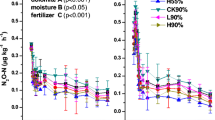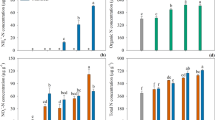Abstract
Soil acidification is a major problem for sustainable agriculture since it limits productivity of several crops. Liming is usually adopted to ameliorate soil acidity that can trigger soil processes such as nitrification, denitrification, and loss of nitrogen (N) as nitrous oxide (N2O) emissions. The loss of N following liming of acidic soils can be controlled by nitrification inhibitors (such as dicyandiamide). However, effects of nitrification inhibitors following liming of acidic soils are not well understood so far. Here, we conducted a laboratory study using an acidic soil to examine the effects of dolomite and dicyandiamide (DCD) application on N2O emissions. Three levels of DCD (0, 10, and 20 mg kg−1; DCD0, DCD10, and DCD20, respectively) were applied to the acidic soil under two levels of dolomite (0 and 1 g kg−1) which were further treated with two levels of N fertilizer (0 and 200 mg N kg−1). Results showed that N2O emissions were highest at low soil pH levels in fertilizer-treated soil without application of DCD and dolomite. Application of DCD and dolomite significantly (P ≤ 0.001) reduced N2O emissions through decreasing rates of NH4 +-N oxidation and increasing soil pH, respectively. Total N2O emissions were reduced by 44 and 13 % in DCD20 and dolomite alone treatments, respectively, while DCD20 + dolomite reduced N2O emissions by 54 % when compared with DCD0 treatment. The present study suggests that application of DCD and dolomite to acidic soils can mitigate N2O emissions.




Similar content being viewed by others
References
Abbasi M, Adams W (2000) Estimation of simultaneous nitrification and denitrification in grassland soil associated with urea-N using 15N and nitrification inhibitor. Biol Fertil Soils 31:38–44
Baggs EM, Smales CL, Bateman EJ (2010) Changing pH shifts the microbial sources well as the magnitude of N2O emission from soil. Biol Fertil Soils 46:793–805
Bakken LR, Bergaust L, Liu B, Frostegard A (2012) Regulation of denitrification at the cellular level: a clue to the understanding of N2O emissions from soils. Philos Trans R Soc B-Biol Sci 367:1226–1234
Barton L, Murphy DV, Butterbach-Bahl K (2013) Influence of crop rotation and liming on greenhouse gas emissions from a semi-arid soil. Agric Ecosyst Environ 167:23–32
Bergaust L, Mao Y, Bakken LR, Frostegard A (2010) Denitrification response patterns during the transition to anoxic respiration and posttranscriptional effects of suboptimal pH on nitrogen oxide reductase in paracoccus denitrificans. Appl Environ Microbiol 76:6387–6396
Bolland M, Gazey C, Miller A, Gartner D, Roche J (2004) Subsurface acidity. Department of Agriculture, Western Australia, Locked Bag No. 4, Bentley Delivery Centre, WA 6983, 15 pp
Ciais P, Sabine C, Bala G, Bopp L, Brovkin V, Canadell J, Chhabra A, DeFries R, Galloway J, Heimann M (2014): Carbon and other biogeochemical cycles, Climate Change 2013: The Physical Science Basis. Contribution of Working Group I to the Fifth Assessment Report of the Intergovernmental Panel on Climate Change. Cambridge University Press, pp. 465–570
de Klein CAM, Cameron KC, Di HJ, Rys G, Monaghan RM, Sherlock RR (2011) Repeated annual use of the nitrification inhibitor dicyandiamide (DCD) does not alter its effectiveness in reducing N2O emissions from cow urine. Anim Feed Sci Technol 166–67:480–491
Di H, Cameron K, Sherlock R (2007) Comparison of the effectiveness of a nitrification inhibitor, dicyandiamide, in reducing nitrous oxide emissions in four different soils under different climatic and management conditions. Soil Use Manag 23:1–9
Di H, Cameron K, Shen J, He J, Winefield C (2009a) A lysimeter study of nitrate leaching from grazed grassland as affected by a nitrification inhibitor, dicyandiamide, and relationships with ammonia oxidizing bacteria and archaea. Soil Use Manag 25:454–461
Di H, Cameron K, Shen JP, Winefield C, O’Callaghan M, Bowatte S, He J (2009b) Nitrification driven by bacteria and not archaea in nitrogen-rich grassland soils. Nat Geosci 2:621–624
Field C, Barros V, Dokken D, Mach K, Mastrandrea M, Bilir T, Chatterjee M, Ebi K, Estrada Y, Genova R (2014) IPCC, 2014: Climate Change 2014: Impacts, Adaptation, and Vulnerability. Part A: Global and Sectoral Aspects. Contribution of Working Group II to the Fifth Assessment Report of the Intergovernmental Panel on Climate Change. Cambridge University Press, Cambridge, United Kingdom and New York, NY, USA
Guo J, Liu X, Zhang Y, Shen J, Han W, Zhang W, Christie P, Goulding K, Vitousek P, Zhang F (2010) Significant acidification in major Chinese croplands. Science 327:1008–1010
He J, Shen J, Zhang L, Zhu Y, Zheng Y, Xu M, Di H (2007) Quantitative analyses of the abundance and composition of ammonia-oxidizing bacteria and ammonia-oxidizing archaea of a Chinese upland red soil under long-term fertilization practices. Environ Microbiol 9:2364–2374
Higgins S, Laughlin RJ, Watson CJ (2013) Antecedent effect of lime on nitrous oxide and dinitrogen emissions from grassland soils. Nutr Cycl Agroecosyst 95:219–229
Hu X-K, Su F, Ju X-T, Gao B, Oenema O, Christie P, Huang B-X, Jiang R-F, Zhang F-S (2013) Greenhouse gas emissions from a wheat–maize double cropping system with different nitrogen fertilization regimes. Environ Pollut 176:198–207
Islam A, White RE, Chen D (2006) Nitrification activity in acid soils of north-eastern Victoria, Australia, as affected by liming and phosphorus fertilisation. Soil Res 44:739–744
Jin X, Huang J, Zhou Y (2012) Impact of coastal wetland cultivation on microbial biomass, ammonia-oxidizing bacteria, gross N transformation and N2O and NO potential production. Biol Fertil Soils 48:363–369
Kelliher F, Clough T, Clark H, Rys G, Sedcole J (2008) The temperature dependence of dicyandiamide (DCD) degradation in soils: a data synthesis. Soil Biol Biochem 40:1878–1882
Kelly KB, Phillips FA, Baigent R (2008) Impact of dicyandiamide application on nitrous oxide emissions from urine patches in northern Victoria, Australia. Aust J Exp Agric 48:156–159
Lang M, Cai Z, Chang SX (2011) Effects of land use type and incubation temperature on greenhouse gas emissions from Chinese and Canadian soils. J Soils Sediments 11:15–24
Lin S, Iqbal J, Hu R, Shaaban M, Cai J, Chen X (2013) Nitrous oxide emissions from yellow brown soil as affected by incorporation of crop residues with different carbon-to-nitrogen ratios: a case study in central China. Arch Environ Contam Toxicol 65:183–192
Liu S, Hu R, Zhao J, Brüggemann N, Bol R, Cai G, Lin S, Shaaban M (2014) Flooding effects on soil phenol oxidase activity and phenol release during rice straw decomposition. J Plant Nutr Soil Sci 177:541–547
Lubbers IM, Brussaard L, Otten W, van Groenigen JW (2011) Earthworm-induced N mineralization in fertilized grassland increases both N2O emission and crop-N uptake. Eur J Soil Sci 62:152–161
Matson P, Lohse KA, Hall SJ (2002) The globalization of nitrogen deposition: consequences for terrestrial ecosystems. Ambio 31:113–119
Millar N, Robertson GP, Grace PR, Gehl RJ, Hoben JP (2010) Nitrogen fertilizer management for nitrous oxide (N2O) mitigation in intensive corn (Maize) production: an emissions reduction protocol for US Midwest agriculture. Mitig Adapt Strat Glob Chang 15:185–204
O’Callaghan M, Gerard EM, Carter PE, Lardner R, Sarathchandra U, Burch G, Ghani A, Bell N (2010) Effect of the nitrification inhibitor dicyandiamide (DCD) on microbial communities in a pasture soil amended with bovine urine. Soil Biol Biochem 42:1425–1436
Page K, Allen D, Dalal R, Slattery W (2010) Processes and magnitude of CO2, CH4, and N2O fluxes from liming of Australian acidic soils: a review. Soil Res 47:747–762
Qu Z, Wang J, Almøy T, Bakken LR (2013) Excessive use of nitrogen in Chinese agriculture results in high N2O/(N2O+ N2) product ratio of denitrification, primarily due to acidification of the soils. Glob Chang Biol 20:1685–1698
Robinson A, Di HJ, Cameron KC, Podolyan A, He J (2014) The effect of soil pH and dicyandiamide (DCD) on N2O emissions and ammonia oxidiser abundance in a stimulated grazed pasture soil. J Soils Sediments 14:1434–1444
Shaaban M, Abid M, Qi-An P (2013a) Short term influence of gypsum, farm manure and commercial humic acid on physical properties of salt affected soil in rice paddy system. J Chem Soc Pak 35:1034–1040
Shaaban M, Abid M, Abou-Shanab RAI (2013b) Amelioration of salt affected soils in rice paddy system by application of organic and inorganic amendments. Plant Soil Environ 59:227–233
Shaaban M, Peng Q, Hu R, Lin S, Wu Y, Ullah B, Zhao J, Liu S, Li Y (2014a) Dissolved organic carbon and nitrogen mineralization strongly affect CO2 emissions following lime application to acidic soil. J Chem Soc Pak 36:875–879
Shaaban M, Peng Q, Lin S, Wu Y, Zhao J, Hu R (2014b) Nitrous oxide emission from two acidic soils as affected by dolomite application. Soil Res 52:841–848
Shaaban M, Peng Q, HR, Wu Y, Lin S, Zhao J (2015) Dolomite application to acidic soils: a promising option for mitigating N2O emissions. Environ Sci Pollut Res. doi:10.1007/s11356-015-5238-4
Simek M, Cooper JE (2002) The influence of soil pH on denitrification: progress towards the understanding of this interaction over the last 50 years. Eur J Soil Sci 53:345–354
Singh J, Saggar S, Giltrap DL, Bolan NS (2008) Decomposition of dicyandiamide (DCD) in three contrasting soils and its effect on nitrous oxide emission, soil respiratory activity, and microbial biomass-an incubation study. Soil Res 46:517–525
Soil Survey Staff (2010) Keys to Soil Taxonomy. 11th edn (USDA Natural Resources Conservation Service: Washington, DC)
Sun W, Huang Y (2012) Synthetic fertilizer management for China’s cereal crops has reduced N2O emissions since the early 2000s. Environ Pollut 160:24–27
Verma A, Tyagi L, Singh S (2008) Attenuation of N2O emission rates from agricultural soil at different dicyandiamide concentrations. Environ Monit Assess 137:287–293
Von-Uexküll H, Mutert E (1995) Global extent, development and economic impact of acid soils. Plant Soil 171:1–15
Wakelin S, Williams E, O’Sullivan CA, Cameron KC, Di HJ, Cave V, O’Callaghan M (2014) Predicting the efficacy of the nitrification inhibitor dicyandiamide in pastoral soils. Plant Soil 381:35–43
Wang Y, Wang Y (2003) Quick measurement of CH4, CO2 and N2O emissions from a short-plant ecosystem. Adv Atmos Sci 20:842–844
Weslien P, Kasimir Klemedtsson Å, Börjesson G, Klemedtsson L (2009) Strong pH influence on N2O and CH4 fluxes from forested organic soils. Eur J Soil Sci 60:311–320
Yamulki S, Harrison RM, Goulding K, Webster C (1997) N2O, NO and NO2 fluxes from a grassland: effect of soil pH. Soil Biol Biochem 29:1199–1208
Zaman M, Blennerhassett J (2010) Effects of the different rates of urease and nitrification inhibitors on gaseous emissions of ammonia and nitrous oxide, nitrate leaching and pasture production from urine patches in an intensive grazed pasture system. Agric Ecosyst Environ 136:236–246
Acknowledgments
Authors are grateful to Dr. Rob Harris, Research Scientist (Hamilton, Victoria, Australia) for checking earlier version of this manuscript. Authors are also thankful to anonymous reviewers for providing constructive comments. This research work was financially supported by the National Natural Science Foundation of China (41171212) and the National Basic Research Program of China (2012CB417106).
Author information
Authors and Affiliations
Corresponding authors
Additional information
Responsible editor: Zhihong Xu
Rights and permissions
About this article
Cite this article
Shaaban, M., Wu, Y., Peng, Qa. et al. Effects of dicyandiamide and dolomite application on N2O emission from an acidic soil. Environ Sci Pollut Res 23, 6334–6342 (2016). https://doi.org/10.1007/s11356-015-5863-y
Received:
Accepted:
Published:
Issue Date:
DOI: https://doi.org/10.1007/s11356-015-5863-y




